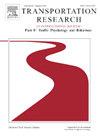Enhancing passenger-vehicle interaction through multimodal explanation for unexpected behaviors of fully autonomous driving in non-driving-related tasks
IF 3.5
2区 工程技术
Q1 PSYCHOLOGY, APPLIED
Transportation Research Part F-Traffic Psychology and Behaviour
Pub Date : 2025-02-01
DOI:10.1016/j.trf.2025.01.045
引用次数: 0
Abstract
This study investigates the effects of multimodal explainable artificial intelligence (XAI) interfaces on passenger experience during unexpected behaviors of fully autonomous vehicles (FAVs) when engaging in non-driving-related tasks (NDRTs). An experiment was conducted with 70 participants using a driving simulator. The experiment was designed as a 2 (performing NDRT or not) × 2 (textual explanation or none) × 2 (speech explanation with sound or sound only) between-subject design, focusing on user experience (UX), explanation satisfaction, situation awareness, and trust regarding multimodal XAI interfaces. We included eight unexpected driving situations (i.e., weather type, traffic condition, etc.) that were required as unusual and strange. The findings showed an interaction effect between NDRTs and speech explanations for pragmatic and hedonic qualities of UX. When passengers were in NDRTs, the effectiveness of multimodal XAI interfaces was worse than presenting no explanation at all. When passengers were not in NDRTs, multimodal XAI interfaces improved the overall qualities of UX. Single modality explanations also had a positive effect compared to none, with auditory speech explanations superior to visual ones. These findings have practical implications for supporting effective passenger-vehicle interaction systems that cater to varying user contexts. Specifically, this study demonstrates how well-crafted explanations can enhance trust, situation awareness, and user satisfaction, depending on NDRTs engagement. The results provide actionable insights for developing user-centered design guidelines for XAI interfaces, ensuring a positive UX in FAVs under dynamic and unexpected driving conditions.
求助全文
约1分钟内获得全文
求助全文
来源期刊
CiteScore
7.60
自引率
14.60%
发文量
239
审稿时长
71 days
期刊介绍:
Transportation Research Part F: Traffic Psychology and Behaviour focuses on the behavioural and psychological aspects of traffic and transport. The aim of the journal is to enhance theory development, improve the quality of empirical studies and to stimulate the application of research findings in practice. TRF provides a focus and a means of communication for the considerable amount of research activities that are now being carried out in this field. The journal provides a forum for transportation researchers, psychologists, ergonomists, engineers and policy-makers with an interest in traffic and transport psychology.

 求助内容:
求助内容: 应助结果提醒方式:
应助结果提醒方式:


